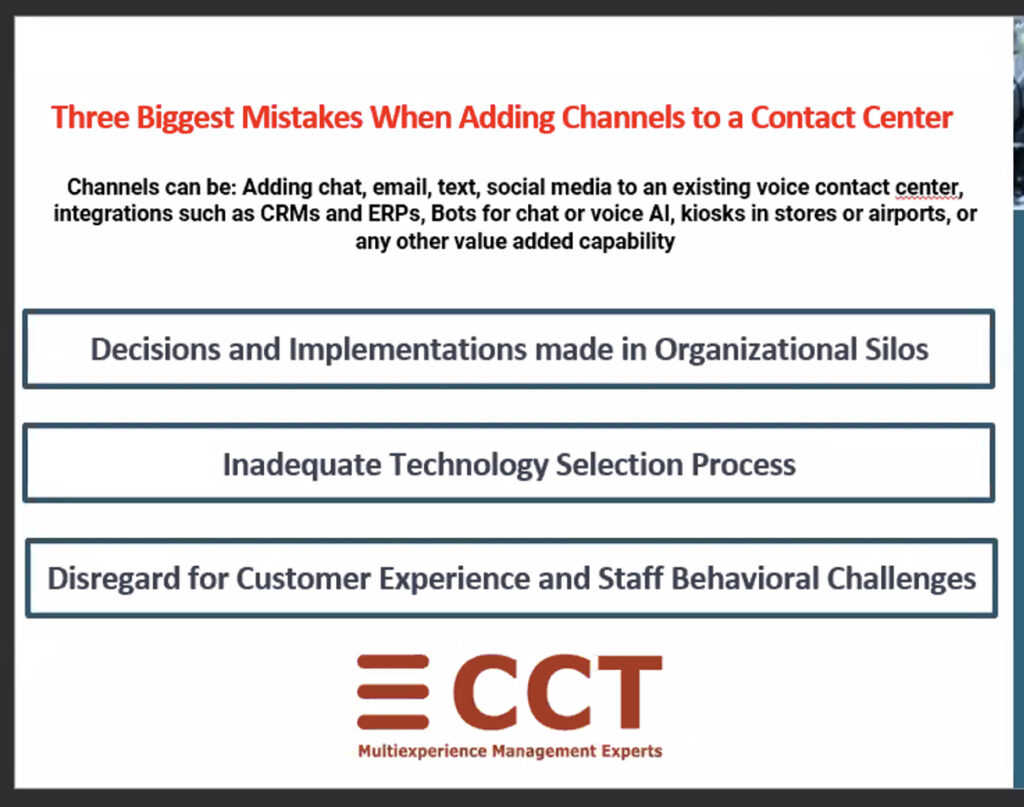Today, more and more customers are using chat, email, text and social media to reach out to your organization. But adding these types of digital channels to a traditional voice contact center is not a simple task.
For instance, you first need to identify which channels are most important to your customers, members, patients or other audience. That will allow you to prioritize certain channels, rather than trying to add everything all at once.
But that’s just one of the challenges, according to panelists in a May 3 BrightTalk webinar, “Three Biggest Mistakes When Adding Channels to a Contact Center,” sponsored by CCT Solutions. Noting that each channel has its own nuances, moderator Kenneth DuPont, vice president, CCT Solutions, added “There can be disconnects throughout the organization in terms of goals, as well as implementations.”

Here are the three key challenges discussed by the panelists.
1. Decisions and implementations made in organizational silos.
Brett Shockley, founder and CEO, Journey.ai, kicked off the discussion by noting the importance of determining use cases within the organization. “Different channels are best for different situations,” he said. “Think about how your customers will enter the journey and try to create an experience that can cross channels.” For instance, a digital tool could be used to authenticate a customer’s identity and then pass that validation on to an agent speaking with the customer on a voice call.
Sergey Razin, Ph.D., CTO, Swampfox Technologies, pointed out that text and voice channels don’t work the same way. “How you phrase questions on each channel matters,” he said. “A strong partner can help you connect the dots.”
Focusing on an organizational department like marketing or IT makes it much harder for to justify technology investments, said Hui Wu-Curtis, president and CEO, World Connection. “Operations may have one idea regarding customer expectations, while IT may have another idea,” she said. “Put some thought into how a solution can serve your particular demographic, and look at how best to use these solutions enterprise-wide in order to build a stronger business case.”
DuPont agreed, citing a speech analytics project at a large Las Vegas casino that failed because it did not meet the organization’s financial expectations.
2. Inadequate technology selection process.
Uwe Kreuter, co-founder and CEO, CCT Solutions, said organizations looking to add digital channels should look carefully at how well vendors’ solutions can be integrated with a companywide CRM, ERP or AI application.
“Before you sit down and start writing out questions for an RFP, be sure you understand the business needs,” said Kreuter. “Otherwise, you won’t be able to write down your requirements. You should also look at a potential vendor’s timeframe. Some can do fast deployments, while others may take years to implement a multiexperience customer management structure.”
Other issues to consider when preparing an RFP include how to serve customers with multiple phone numbers and email addresses. You should also look at how reporting is done between systems, as well as administrative, security and data privacy aspects.
3. Disregard for customer experience and staff behavioral challenges.
Don’t focus on cutting costs when planning to add digital channels to the contact center, agreed the panelists. “While it’s easier to automate digital channels, people still want to talk to agents,” said Kreuter. “Instead, look at perfecting the orchestration among channels, so the agent gets the information to deliver an excellent customer experience.”
Educating and training is another aspect of implementing digital channels, said Shockley. Rather than having agents worry about losing their jobs, he suggested bringing them into the project planning process. “Help them design how the flows from digital to human will work,” he said. “It’s so important to take a holistic approach and involve the contact center team.”
Summing up the discussion, Wu-Curtis said, “There’s not one formula that applies to all organizations. So, you have to find the right balance, automate the low-value items and be sure that higher-value actions get passed seamless to a human being.”
